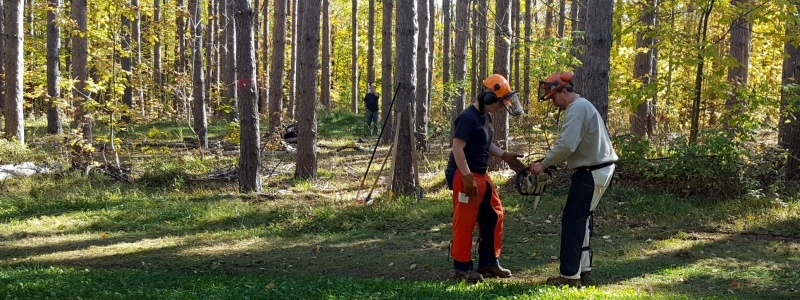Use your bachelor's degree in another field as a springboard to enter the workforce as an accredited forester.
Mark timber stands, determine how much to remove, and plan how to remove it. Work with private and public landowners, including loggers and environmental groups. Join a professional trail crew. Be a forest firefighter. Work as an arborist, climbing, pruning, and treating trees for pests and diseases. Credentialed by the Society of American Foresters, this professional degree—different than a traditional master of science degree—prepares you for a career in forestry working where you want to be: outdoors.
For specific requirements of this graduate program please see the CFRES Graduate Handbook | Printable.
An accelerated option is available to Michigan Tech students pursuing undergraduate forestry degrees. The current curriculum is for students beginning Fall of 2017. In order to keep up with accreditation standards, a revised degree schedule will be in place for Fall 2018.
MF Program Mission
Our goal is to train foresters to effectively manage our lands and natural resources using strong field and analytical skills, disciplinary knowledge, and professionalism. Accredited by the Society of American Foresters, the MF curriculum includes coursework enriched with cutting-edge science in the areas of forest ecology and biology, measurement of forest resources, forest management, forest policy and administration, and professional ethics. The MF experience culminates with a semester-long integrated field practicum, and developing and communicating a professional forest management plan.
MF Learning Outcomes
- Disciplinary Knowledge - Students develop an advanced knowledge of the field of forestry.
- Field and Analytic Skills - Students develop a strong set of field and analytic skills related to natural resource management.
- Solve Problems - Students provide and evaluate alternative solutions based on advanced application of the scientific method to problems in forestry.
- Professionalism and Teamwork - Students develop skills that enable them to communicate with a high level of professionalism and conduct work effectively as part of a team.
- Employment Readiness - Students are prepared to move into full-time permanent positions in the field of forestry through a combination of their graduate studies, undergraduate studies, and work experience.
Program Strengths and Opportunities
- Two pathways, 30 hours: Students who have already graduated with an SAF-accredited bachelor's degree enhance their credentials and employability with training in advanced technologies, natural resource policy, business economics, and engineering technologies.
- Students earning their SAF-accreditation complete the requirements through a comprehensive forestry curriculum including identification of biology of forest vegetation, ecological processes of forests, soil science, remote sensing and GIS, and timber harvesting.
- Both pathways include a field-based component, including University and community recreational, research, and industrial projects with our Forest and Environmental Resource Management program (aka the FERM).
- 6,500 feet of lab space, 2,000 of greenhouse, 4,609 acres of research forest.
- We focus on your ability to use and apply emerging technologies, including remote sensing, geographic information systems (GIS), statistical modeling, and business principals in forest management situations.
- Course work is completed in three semesters, with new students starting in fall semester. There is a set curriculum, but many students have flexibility in course selection because they have already satisfied some required courses and skills.
- Students can include extra classes in their particular field of interest and choose to include a research project.
"Everyone in the Master of Forestry program came from different backgrounds, but we quickly bonded while taking classes together became great friends. (And I mean really different undergraduate degrees: philosophy, law enforcement, ancient languages and archeology, outdoor education, wildlife, environmental science, and of course illustration). "
